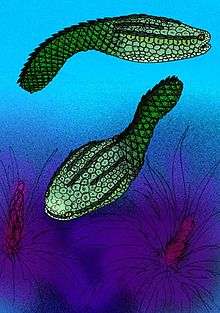Astraspis
| Astraspis Temporal range: 467–443 Ma middle-late Ordovician | |
|---|---|
 | |
| Astraspis desiderata | |
| Scientific classification | |
| Kingdom: | Animalia |
| Phylum: | Chordata |
| Class: | Pteraspida |
| Subclass: | Astraspida |
| Order: | Astraspidiformes |
| Genus: | Astraspis |
| Species | |
| |
Astraspis ('star shield') is an extinct genus of primitive jawless fish from the Ordovician of Central North America and Bolivia.[1] It is related to other Ordovician fishes, such as the South American Sacabambaspis, and the Australian Arandaspis.
Description
Nearly complete fossils suggest the living animals were about 200 mm (7.9 in) in length. The body had a mobile tail covered with small protective plate-like scales of less than 1 mm (0.039 in) and a forebody covered with plate-like scales larger than 2 mm (0.079 in). The specimen from North America (described by Sansom et al., 1997) is to have had relatively large, laterally-positioned eyes and a series of eight gill openings on each side. The specimen was generally oval in cross-section. The protective bony plates covering the animal were composed of aspidin (chemically similar to modern shark's teeth), covered by tubercles composed of dentine.[2] It is from these tubercles (which are generally star-shaped) that the name 'Astraspis' (literally "star-shield") is derived.
References
- ↑ Sacabambaspis janvieri. PY Gagnier - Vertébré ordovicien de Bolivie, 1993
- ↑ Sansom IJ, Smith MP, Smith MM and Turner P (1997) "Astraspis: The anatomy and histology of an Ordovician fish" Palaeontology, 40 (3): 625–642.
Other sources
Michael J. Benton, Vertebrate Palaeontology, 3rd edition, 2005